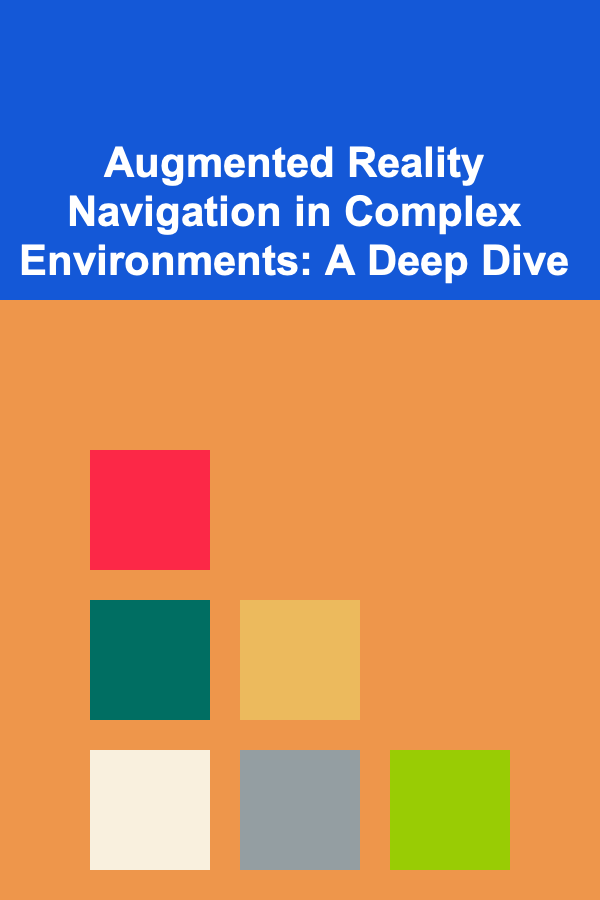
Augmented Reality Navigation in Complex Environments: A Deep Dive
ebook include PDF & Audio bundle (Micro Guide)
$12.99$11.99
Limited Time Offer! Order within the next:

Augmented Reality (AR) is rapidly transforming how we interact with the world around us. While early applications focused on entertainment and gaming, AR's potential extends far beyond, offering powerful solutions for a wide range of real-world problems. One particularly promising area is enhanced navigation, especially within complex environments. This article will explore the challenges of navigating complex environments, delve into how AR addresses these challenges, examine the technologies and techniques involved, discuss practical applications across various sectors, and finally, address the ethical considerations and future directions of AR-based navigation.
The Challenge of Navigation in Complex Environments
Navigating unfamiliar or intricate spaces presents significant hurdles. These environments can range from sprawling hospital complexes and labyrinthine warehouses to multi-story office buildings and disaster zones. The challenges stem from several factors:
- Cognitive Overload: Traditional maps and signage often require users to constantly switch their attention between the physical environment and a separate display (e.g., a paper map or a smartphone screen). This cognitive load can be overwhelming, especially in time-sensitive or stressful situations.
- Spatial Disorientation: Lack of landmarks, repetitive layouts, and obscured visibility can lead to spatial disorientation, making it difficult to maintain a sense of direction and plan the most efficient route. Imagine being in a large, windowless convention center where every hallway looks identical.
- Accessibility Barriers: Existing navigation systems may not be adequately accessible for individuals with disabilities. For example, traditional signage might be difficult to read for visually impaired individuals, or routes might not be optimized for wheelchair users.
- Real-time Updates: Static maps and signage are inherently limited in their ability to provide real-time information. They cannot dynamically adapt to changing conditions, such as construction, temporary closures, or emergency situations. A hallway blocked due to cleaning is a simple example.
- Lack of Personalization: Standard navigation systems treat all users the same, regardless of their individual needs or preferences. Someone rushing to a meeting has different needs than someone leisurely exploring a museum.
These challenges can result in wasted time, increased stress, reduced efficiency, and even safety risks. In emergency situations, efficient navigation can be a matter of life and death.
How AR Enhances Navigation: Bridging the Digital and Physical Worlds
AR offers a compelling solution to these navigation challenges by seamlessly overlaying digital information onto the real world. By using smartphones, tablets, or dedicated AR headsets, users can view contextual information, such as turn-by-turn directions, points of interest, and safety alerts, directly superimposed on their view of the environment.
Here's how AR addresses the specific challenges outlined above:
- Reduced Cognitive Load: AR minimizes the need to switch focus between the real world and a separate display. By presenting information directly within the user's field of view, it reduces cognitive overload and allows for more intuitive navigation. Imagine seeing an arrow projected onto the floor guiding you to your destination.
- Improved Spatial Awareness: AR can provide visual cues and landmarks that enhance spatial awareness. For example, it can highlight the correct path with a virtual overlay, create virtual waypoints to guide users through complex layouts, or display 3D models of buildings to provide a better understanding of the overall structure.
- Enhanced Accessibility: AR can be tailored to meet the specific needs of users with disabilities. For example, it can provide audio descriptions of the environment, offer alternative routes for wheelchair users, or adjust the size and contrast of visual elements for visually impaired individuals.
- Dynamic Information Updates: AR systems can be integrated with real-time data sources to provide dynamic updates on changing conditions. This could include alerts about construction zones, temporary closures, or emergency situations. For example, an AR app could reroute you around a fire hazard detected by sensors.
- Personalized Navigation Experiences: AR can personalize the navigation experience based on user preferences, roles, and goals. It can prioritize information relevant to the user's current task, offer customized routes based on their preferences, and provide location-specific information based on their profile. A maintenance worker would see different overlays than a visitor.
In essence, AR transforms navigation from a passive activity of following directions to an active and engaging experience of interacting with the environment. It empowers users to navigate complex spaces with greater confidence, efficiency, and safety.
Technologies and Techniques Behind AR Navigation
Building an effective AR navigation system requires a combination of hardware, software, and sophisticated algorithms. Here's a breakdown of the key technologies and techniques involved:
- Hardware:
- Mobile Devices (Smartphones & Tablets): These are the most common platform for AR navigation due to their widespread availability and integrated sensors (camera, GPS, accelerometer, gyroscope).
- AR Headsets (e.g., HoloLens, Magic Leap): These offer a more immersive and hands-free AR experience, allowing users to view digital information directly within their field of view.
- Wearable Sensors: Devices like smartwatches and fitness trackers can provide additional data, such as user's gait and orientation, which can be used to improve the accuracy and responsiveness of the AR navigation system.
- Software:
- AR Development Platforms (e.g., ARKit, ARCore, Unity, Unreal Engine): These provide the tools and frameworks needed to develop AR applications. They offer features like object tracking, scene understanding, and rendering.
- Computer Vision Libraries (e.g., OpenCV): These provide algorithms for image processing, object detection, and feature extraction, which are essential for understanding the environment and tracking the user's position.
- Navigation SDKs (e.g., Mapbox, Google Maps API): These provide routing algorithms, map data, and geocoding services that are used to calculate the optimal route and display map information.
- Indoor Positioning Systems (IPS): These provide accurate location information indoors, where GPS signals are often unavailable or unreliable. Technologies include Wi-Fi triangulation, Bluetooth beacons, inertial sensors, and ultra-wideband (UWB) ranging.
- Algorithms and Techniques:
- Simultaneous Localization and Mapping (SLAM): SLAM algorithms allow the device to build a map of the environment while simultaneously tracking its own position within that map. This is crucial for accurate and robust AR navigation.
- Sensor Fusion: Combining data from multiple sensors (e.g., camera, accelerometer, gyroscope, GPS) to improve the accuracy and reliability of position tracking and orientation estimation. For example, using accelerometer data to smooth out GPS inaccuracies.
- Visual Inertial Odometry (VIO): A specific SLAM technique that combines visual information from the camera with inertial measurements from the accelerometer and gyroscope to estimate the device's motion.
- Pathfinding Algorithms (e.g., A*, Dijkstra's Algorithm): These algorithms are used to calculate the optimal route between two points, taking into account factors such as distance, obstacles, and user preferences.
- Object Recognition and Scene Understanding: Identifying and understanding objects in the environment (e.g., doors, walls, signs) to provide context-aware navigation assistance. Knowing a door leads to a different room is crucial.
- Machine Learning (ML): ML can be used to improve the accuracy of indoor positioning systems, predict user behavior, and personalize the navigation experience. For example, learning frequent paths taken by a user.
The interplay of these technologies and techniques is critical for creating a seamless and effective AR navigation experience. For example, SLAM helps the AR system understand the environment, VIO provides accurate motion tracking, and pathfinding algorithms ensure the user is guided along the optimal route.
Applications Across Various Sectors
The potential applications of AR navigation are vast and span across numerous sectors. Here are some key examples:
- Healthcare:
- Hospital Navigation: Guiding patients and visitors to specific departments, rooms, or facilities within complex hospital buildings. This can reduce stress, improve patient satisfaction, and free up staff time.
- Emergency Response: Assisting medical personnel in locating patients, equipment, or resources during emergency situations. Directing responders to a specific patient in a chaotic emergency room.
- Surgical Navigation: AR can overlay pre-operative imaging data onto the patient's body during surgery, providing surgeons with real-time guidance and improving the precision of surgical procedures.
- Manufacturing and Logistics:
- Warehouse Navigation: Guiding warehouse workers to specific items or locations within large and complex warehouses. This can improve order picking efficiency, reduce errors, and optimize inventory management.
- Assembly Line Assistance: Providing workers with step-by-step instructions and visual aids for assembling complex products. This can improve product quality, reduce training time, and increase productivity.
- Maintenance and Repair: Overlaying schematics and repair instructions onto equipment during maintenance and repair tasks. This can improve the accuracy and efficiency of maintenance operations.
- Retail:
- In-Store Navigation: Guiding shoppers to specific products or departments within large retail stores. This can improve customer experience, increase sales, and provide valuable data on shopper behavior.
- Product Information: Displaying product information, reviews, and promotions when shoppers are near a particular product. This can enhance the shopping experience and influence purchase decisions.
- Education and Training:
- Campus Navigation: Guiding students and visitors to classrooms, labs, and other facilities on university campuses.
- Interactive Learning Experiences: Creating interactive learning experiences that overlay digital content onto the real world. For example, students could use AR to explore the anatomy of the human body or visualize historical events.
- Simulation Training: Using AR to create realistic simulations for training purposes. For example, firefighters could use AR to practice firefighting techniques in a simulated environment.
- Tourism and Cultural Heritage:
- Museum and Gallery Navigation: Guiding visitors through museums and galleries, providing information about exhibits and artwork.
- Historical Site Reconstruction: Overlaying digital reconstructions of historical sites onto the real world, allowing visitors to experience the past in a more immersive way.
- Emergency Response and Disaster Relief:
- Search and Rescue: Helping rescuers navigate through disaster zones and locate survivors. Overlaying maps and information on damaged structures.
- Damage Assessment: Providing first responders with real-time information about the extent of damage and the location of hazards.
These are just a few examples of the diverse applications of AR navigation. As the technology continues to evolve, we can expect to see even more innovative applications emerge in the years to come.
Ethical Considerations and Challenges
While AR navigation offers numerous benefits, it also raises several ethical considerations and challenges that need to be addressed:
- Privacy: AR navigation systems often collect and store user location data. It is important to ensure that this data is protected and used responsibly. Clear data privacy policies and user consent mechanisms are crucial.
- Security: AR systems can be vulnerable to security threats, such as hacking and data breaches. Robust security measures are needed to protect user data and prevent malicious actors from manipulating the system.
- Accessibility: AR navigation systems should be designed to be accessible to all users, including individuals with disabilities. This includes providing alternative input methods, customizable interfaces, and audio descriptions.
- Cognitive Overload: While AR can reduce cognitive load in some situations, it can also increase it if the information presented is overwhelming or poorly designed. It's important to carefully consider the design of the AR interface to avoid overwhelming the user with too much information. The principle of "less is more" is particularly important here.
- Distraction and Safety: AR can distract users from their surroundings, potentially leading to accidents. It's important to design AR systems that minimize distraction and promote safe behavior. For example, AR navigation systems should provide clear warnings about potential hazards and encourage users to pay attention to their surroundings.
- Digital Divide: Access to AR technology and infrastructure may be unevenly distributed, potentially exacerbating existing inequalities. It's important to ensure that AR navigation systems are accessible to all, regardless of their socioeconomic status or geographic location. Consider the cost of AR devices and the availability of reliable internet access.
- Over-Reliance and Deskilling: Over-reliance on AR navigation could potentially lead to a decrease in users' natural navigation skills and spatial awareness. It's important to encourage users to develop their own navigation skills and not rely solely on AR technology.
Addressing these ethical considerations and challenges is crucial for ensuring that AR navigation is used responsibly and ethically. Open discussions, clear regulations, and user education are all important components of responsible AR development and deployment.
Future Directions and Emerging Trends
The field of AR navigation is rapidly evolving, with several emerging trends and future directions that promise to further enhance its capabilities and applications:
- Improved Indoor Positioning Systems (IPS): Research is ongoing to develop more accurate, robust, and cost-effective IPS solutions. Technologies like ultra-wideband (UWB) and millimeter-wave radar are showing promise for providing highly accurate indoor location information.
- AI-Powered Navigation: Artificial intelligence (AI) is playing an increasingly important role in AR navigation. AI algorithms can be used to improve the accuracy of position tracking, predict user behavior, personalize the navigation experience, and provide more context-aware assistance.
- Semantic SLAM: Traditional SLAM focuses on building geometric maps of the environment. Semantic SLAM extends this by adding semantic information, such as object labels and scene understanding. This allows the AR system to understand the environment at a higher level and provide more intelligent navigation assistance. For example, knowing that a particular area is a "waiting room" allows the system to provide relevant information and guidance.
- Collaborative AR Navigation: Enabling multiple users to share and collaborate on AR navigation experiences. For example, emergency responders could use collaborative AR navigation to coordinate their efforts in a disaster zone.
- Integration with IoT Devices: Integrating AR navigation with Internet of Things (IoT) devices, such as smart sensors and connected appliances. For example, an AR navigation system could guide a user to a malfunctioning piece of equipment in a factory.
- Edge Computing: Offloading computation from the AR device to edge servers to reduce latency and improve performance. This is particularly important for computationally intensive tasks like SLAM and object recognition.
- Miniaturization and Improved Wearability: Continued advancements in hardware technology will lead to smaller, lighter, and more comfortable AR headsets. This will make AR navigation more practical and accessible for a wider range of users. Think of AR glasses that look and feel like regular glasses.
These future directions and emerging trends suggest that AR navigation will continue to transform the way we interact with complex environments, empowering us to navigate with greater confidence, efficiency, and safety.
Conclusion
Augmented Reality offers a powerful solution to the challenges of navigating complex environments. By seamlessly overlaying digital information onto the real world, AR can reduce cognitive load, improve spatial awareness, enhance accessibility, provide dynamic information updates, and personalize the navigation experience. With applications spanning healthcare, manufacturing, retail, education, tourism, and emergency response, AR navigation has the potential to transform numerous sectors. However, ethical considerations and challenges, such as privacy, security, accessibility, and cognitive overload, must be addressed to ensure that AR navigation is used responsibly and ethically. As the technology continues to evolve, with advancements in indoor positioning, AI, semantic SLAM, and miniaturization, AR navigation promises to become an even more integral part of our lives, empowering us to navigate the world around us with greater ease and efficiency.

How to Create an Organized Workspace in Any Room
Read More
How to Inspect and Maintain Your Home's Electrical Panel
Read More
How to Make Your Home Renovation Eco-Friendly
Read More
How to Source Affordable Furniture for Your Home Design
Read More
Navigating the Cloud: Essential Skills for a Cloud Engineer
Read More
Understanding the Geology of Hiking Trails
Read MoreOther Products

How to Create an Organized Workspace in Any Room
Read More
How to Inspect and Maintain Your Home's Electrical Panel
Read More
How to Make Your Home Renovation Eco-Friendly
Read More
How to Source Affordable Furniture for Your Home Design
Read More
Navigating the Cloud: Essential Skills for a Cloud Engineer
Read More